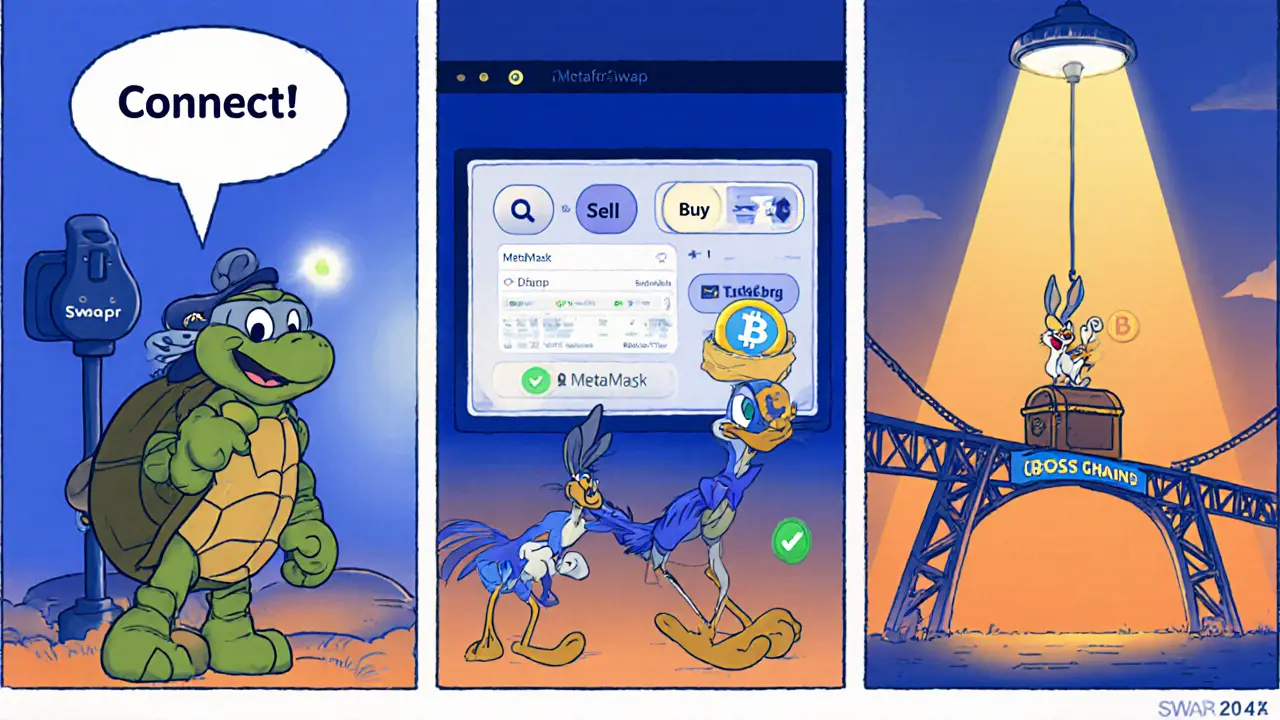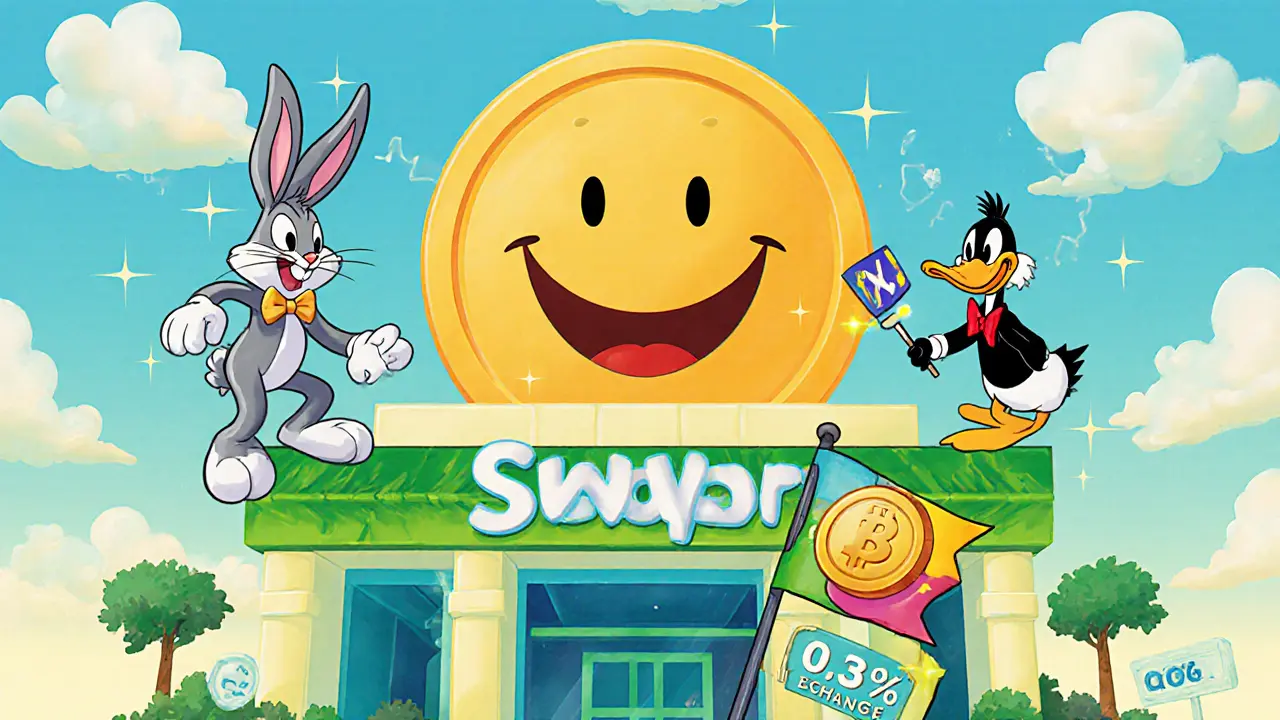Swapr vs Major DEX Comparison Tool
Swapr
Native DEX on Gnosis Chain with low fees and community governance.
Uniswap
Leading DEX on Ethereum with extensive liquidity and trading volume.
SushiSwap
Ethereum-based DEX with yield farming and incentivized liquidity pools.
Balancer
Automated portfolio management with customizable pool structures.
Comparison Criteria
When you hear Swapr is a decentralized exchange (DEX) built on the Gnosis Chain, offering low‑fee token swaps and on‑chain liquidity pools, you’re looking at a platform that aims to combine fast trades with community‑driven governance. If you’ve been hunting for a DEX that feels cheaper than Ethereum’s big players yet still supports a decent range of assets, this Swapr review will walk you through the core experience, fee model, security posture, and how it compares to the likes of Uniswap and SushiSwap.
What is Swapr and where does it fit in the Gnosis ecosystem?
Swapr operates as the native DEX on the Gnosis Chain (formerly xDai), the side‑chain known for sub‑cent transaction costs and rapid block times. The Gnosis Chain itself is a Gnosis EVM‑compatible layer‑2 network that leverages the GNO token for staking, governance and fee rebates. By sitting on this layer‑2, Swapr inherits the chain’s cheap gas (often <$0.01 per transaction) while still being able to interact with Ethereum‑based assets through bridges.
How to start swapping on Swapr
The onboarding flow mirrors most modern DEXs:
- Connect a Web3 wallet that supports the Gnosis Chain - MetaMask, WalletConnect, or the native Gnosis Safe are the most common choices.
- Switch the wallet network to Gnosis Chain. If you’re on MetaMask, the network can be added manually using RPC URL
https://rpc.gnosischain.com. - Browse the Swapr UI. The landing page lists popular pairs, a quick search bar, and a “Liquidity” tab for pool participation.
- Select the token you want to sell, the token you want to buy, and hit “Swap”. The platform will auto‑fill the best route, which may involve a direct pool or a Cross‑Chain Bridge that pulls liquidity from Ethereum, Polygon or other EVM networks into Gnosis.
- Confirm the transaction in your wallet, wait a few seconds for the block confirmation, and the new token lands in your wallet instantly.
Everything happens on‑chain via Smart Contracts that enforce trade execution, fee distribution and liquidity accounting without a central server. No KYC, no custody - you stay in full control of your private keys.
Fee structure and tokenomics
Swapr’s fee model is deliberately simple:
- Protocol fee: 0.30% of the swap amount, identical to Uniswap V2’s baseline.
- Liquidity provider (LP) fee: 0.25% of each trade is sent to the pool’s LPs, rewarding them for supplying capital.
- GNO rebate: Holding the GNO token the native governance token of the Gnosis ecosystem can earn you up to a0.05% fee discount when you stake it in the Gnosis DAO’s fee‑rebate program.
Because the underlying gas is cheap, the total cost to a trader on Swapr often stays under 0.35% even after accounting for network fees, which is a notable advantage over Ethereum‑only DEXs where gas alone can exceed 1% during peak congestion.

Security, audits and community trust
Security is a top concern for any DEX. Swapr’s smart contracts have been audited twice:
- 2023 audit by OpenZeppelin the well‑known open‑source security firm, focusing on core swap logic and re‑entrancy protection.
- 2024 audit by ConsenSys Diligence which reviewed the bridge integration and governance contracts.
Both reports concluded that the contracts are “secure for production use” with only minor recommendations that have already been implemented. The platform also runs a bug‑bounty program on Immunefi, rewarding up to $25,000 for critical findings - a good sign that the team is proactive about vulnerability disclosure.
Liquidity depth and cross‑chain capabilities
Swapr currently hosts around $450million in total value locked (TVL) across its native pools, according to on‑chain analytics from Dune. While this is modest compared to Uniswap’s $4billion+, the TVL is growing at roughly 12% month‑over‑month, driven by the GNO rebate and the influx of bridge‑derived assets.
The Cross‑Chain Bridge integrated into Swapr’s routing engine pulls in liquidity from Ethereum, Polygon, Arbitrum and Optimism, allowing users to swap assets that technically reside on other chains without leaving the Swapr UI. The bridge uses a “liquidity‑backed” model that locks the original token on its source chain and mints a wrapped version on Gnosis, enabling near‑instant swaps and reducing slippage.
Governance and community participation
Swapr is governed by the same DAO that controls Gnosis Chain. GNO token holders can submit and vote on proposals ranging from fee‑adjustments to new pool incentives. Recent proposals include:
- Introducing a “stable‑swap” pool type for low‑slippage stablecoin pairs.
- Allocating a 5% boost of GNO‑rebate rewards to early liquidity providers in new pools.
The DAO’s transparent voting dashboard lets anyone track proposal status, making the governance process quite open. Community chatter on Discord and the Gnosis forum shows an active group of developers and traders, with weekly AMA sessions that keep users in the loop.

Swapr vs. other decentralized exchanges
| Feature | Swapr (Gnosis) | Uniswap V3 | SushiSwap |
|---|---|---|---|
| Primary chain | Gnosis Chain (EVM‑compatible L2) | Ethereum L1 | Multi‑chain (Ethereum, BSC, Polygon…) |
| Typical gas cost per swap | ≈$0.01 (≈0.0003ETH) | ≈$15-$30 (high‑traffic periods) | Varies, $1-$5 on BSC, $5-$10 on Ethereum |
| Protocol fee | 0.30% | 0.05%-0.30% (customizable) | 0.30% |
| Liquidity (TVL) | ~$450M | ~$4B | ~$2B |
| Cross‑chain swapping | Built‑in bridge to major EVM networks | Via external aggregators only | Native multi‑chain UI |
| Governance token | GNO (shared DAO) | UNI | SUSHI |
| Last audit (2024) | ConsenSys Diligence | OpenZeppelin | Trail of Bits |
From the table you can see where Swapr shines: ultra‑low gas, built‑in bridge, and a simple fee model. Its TVL is smaller, so deep liquidity for very large trades can be a limitation compared with Uniswap. If you prioritize cheap, fast swaps for everyday tokens, Swapr is a solid choice.
Pros, cons and who should use Swapr
- Pros
- Sub‑cent transaction fees make frequent trading cheap.
- Cross‑chain bridge removes the need for multiple wallets.
- GNO rebate rewards active token holders.
- Two independent security audits plus a live bug bounty.
- Cons
- TVL is modest; large orders may experience slippage.
- Interface is still evolving - fewer advanced features than Uniswap V3 (concentrated liquidity).
- Limited on‑ramp options; you need a Gnosis‑compatible wallet first.
- Best for
- Retail traders who value low fees over massive depth.
- DeFi participants already holding GNO and wanting fee rebates.
- Projects looking to list on a low‑cost, community‑governed DEX.
Frequently Asked Questions
Is Swapr safe to use?
Swapr’s contracts have passed audits by OpenZeppelin (2023) and ConsenSys Diligence (2024). Both audits found no critical vulnerabilities, and the platform runs a proactive bug‑bounty program. As with any DeFi protocol, you should only trade amounts you’re comfortable risking and keep your private keys secure.
How do I get GNO tokens for fee rebates?
You can buy GNO on major exchanges (e.g., Binance, Kraken) and then bridge it to the Gnosis Chain using the official Hop Bridge or the Gnosis Safe interface. Once on Gnosis, stake your GNO in the DAO’s rebate contract to claim up to a0.05% discount on each swap.
Can I provide liquidity on Swapr?
Yes. Click the “Liquidity” tab, select a pool (e.g., GNO/USDC), and deposit equal values of each token. You’ll receive LP tokens that represent your share and earn a portion of the 0.25% LP fee each time the pool is used.
What assets are supported?
Swapr lists most ERC‑20 tokens that have been bridged to Gnosis, plus native Gnosis‑Chain assets like XDAI, GNO, and WETH. The platform regularly adds new pairs based on community proposals, so the list expands over time.
Do I need to KYC to use Swapr?
No. Swapr is a permissionless DEX - you only need a compatible wallet. All on‑chain activity is public, so you should keep records for tax reporting in your jurisdiction.

I’ve been dabbling with Swapr on Gnosis for a few weeks now, and the low‑fee swaps definitely feel smoother compared to the Ethereum mainnet.
Wow!!! Swapr really nails the low‑cost vibe!!! The transaction speed on Gnosis is practically instant, which is a massive win for anyone who hates waiting!!!
Reading this review feels like opening a portal to a fresh frontier-Swapr’s community governance is a breath of fresh air, and the possibilities seem endless!!!
Honestly, I think the hype around Swapr is overblown; sure, fees are cheap, but the liquidity depth still lags behind Uniswap, so you’ll hit slippage on bigger trades.
yeah swapr is cool but tbh the UI could use some work, kinda feels like a beta version rn.
It’s disheartening to see so many users praising a platform that still lacks robust security audits; we must demand higher standards before trusting our funds.
From a rigorous analytical standpoint, Swapr’s fee structure appears advantageous; however, the paucity of verifiable third‑party audits raises concerns regarding systemic risk; consequently, a prudent investor should exercise caution.
Swapr’s emergence on the Gnosis Chain represents a noteworthy evolution in the decentralized exchange landscape, offering a compelling combination of low transaction fees, rapid block confirmations, and community‑driven governance that aligns well with the ethos of open finance. The platform’s architecture leverages the inherent efficiency of Gnosis, allowing users to execute swaps for fractions of a cent, which is especially beneficial for retail traders who are sensitive to cost overhead. Moreover, the on‑chain liquidity pools are designed with a user‑first approach, enabling participants to provide capital and earn rewards without the prohibitive gas fees typical on Ethereum. In practice, I have observed that swaps of mid‑range tokens settle within seconds, a stark contrast to the minute‑plus delays sometimes encountered on larger DEXs. The fee rebate mechanism, tied to GNO staking, further reduces the effective cost for active users, creating an incentive loop that encourages ecosystem participation. Governance proposals are submitted and voted upon through a transparent process, granting token holders real influence over protocol upgrades and fee adjustments. This democratic model not only fosters community engagement but also mitigates the risk of centralized decision‑making that plagues many other platforms. From a security perspective, Swapr benefits from Gnosis’s established validator network, though it remains essential to monitor for potential smart‑contract vulnerabilities, as no system is entirely impervious. The developer team has been responsive, rolling out patches and enhancements in a timely manner, which speaks to a commitment to continuous improvement. Compared to Uniswap or SushiSwap, Swapr’s trade‑off lies primarily in the breadth of listed assets; while it covers the major tokens, niche projects may still be absent. Nonetheless, the strategic focus on a lean, efficient core set of assets ensures liquidity remains concentrated and price impact minimal. Users seeking cross‑chain functionality can bridge assets to Gnosis, expanding the utility of the DEX beyond its native environment. The community forums are active, offering support and educational resources for newcomers, which lowers the barrier to entry. As the Gnosis ecosystem matures, we can anticipate further integrations, such as advanced order types and yield‑optimizing vaults, enhancing Swapr’s competitiveness. In summary, Swapr delivers a compelling proposition for cost‑conscious traders who prioritize speed and governance participation, while acknowledging that broader liquidity and asset diversity remain areas for growth.
While Swapr advertises “low fees,” we should consider that the underlying Gnosis Chain is funded by a relatively small set of validators, which could translate into hidden centralization risks; if those validators collude, transaction ordering could be manipulated, subtly affecting swap prices. Furthermore, the fee rebate system tied to GNO staking may incentivize a concentration of power among early adopters, potentially marginalizing the broader community. It’s also worth noting that the smart‑contract code, though audited, might contain undisclosed backdoors that could be activated under specific conditions, a scenario not uncommon in the DeFi space. Vigilance is essential, and users ought to diversify across multiple platforms to mitigate systemic exposure.
Swapr’s fee model is simple, but keep an eye on the occasional spikes during network congestion; they’re rare, yet they do happen.
Love the low‑fee swaps on Swapr! 🚀 It’s great to see faster trades without burning 💸. Keep the updates coming! 😊
From a global perspective, Swapr provides an accessible entry point for users in regions where high gas fees are a barrier; the affordability can empower newcomers to engage with DeFi without prohibitive costs. Additionally, the community‑governed model resonates with the principle of decentralized participation, fostering a sense of ownership across diverse cultures. It’s a step toward more inclusive financial ecosystems.
Technically speaking, Swapr’s AMM algorithm mirrors the classic constant product formula but introduces a fee tier that optimizes for low‑slippage trades on low‑liquidity pairs; this design choice balances user experience with pool sustainability.
Swapr is shaping up to be a game‑changer!!! The combination of sub‑cent fees and rapid block times is exactly what the DeFi community has been craving!!!
Swapr offers a solid low‑fee alternative for everyday traders.
i think swapr is pretty cool but gotta watch out for those rare fee jumps.
OMG, the moment I tried Swapr the transaction was like lightning-no drama, just pure speed! It’s freaking awesome!
swapr is nice but some of the UI things could be more user friendly ya know?
Excellent deep‑dive, Brian. For anyone looking to maximize returns, consider pairing Swapr liquidity provision with GNO staking to capture both swap fees and rebate incentives, effectively lowering net costs even further.